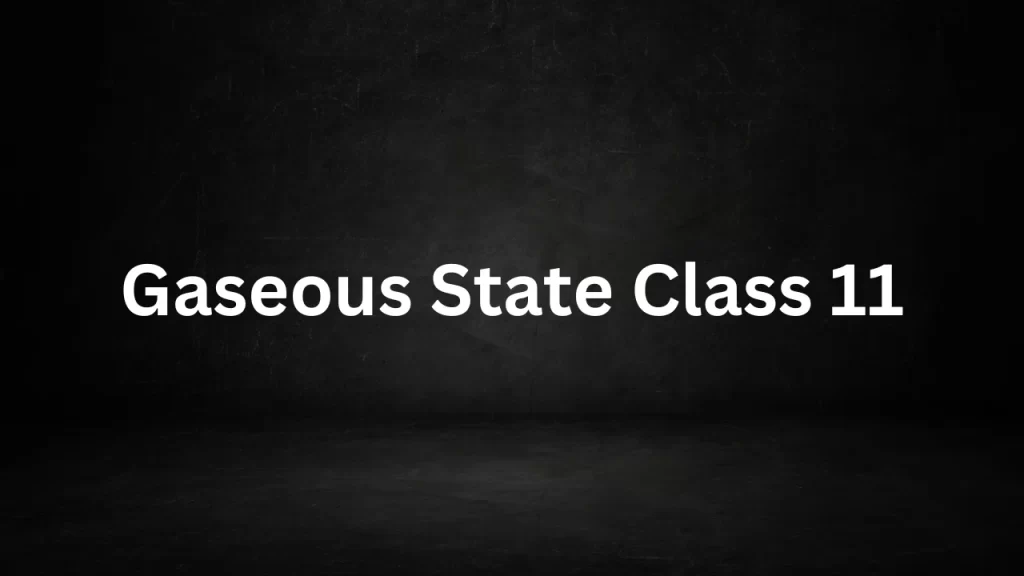Tag: physics wallah gaseous state
Gaseous state class 11
Gaseous state class 11: In the realm of chemistry, the study of matter in different states is essential to understanding its behavior and properties. One of these fundamental states of matter is the gaseous state.
In Class 11 chemistry, students embark on a journey to explore the characteristics, laws, and principles that govern gases. In this article, we will provide an overview of the gaseous state, its basic concepts, and its relevance to the Class 11 curriculum.

Gaseous state class 11
1. Defining the Gaseous State
The gaseous state is one of the three primary states of matter, alongside the solid and liquid states. In this state, substances exist as gases, which have the following key characteristics:
- Gases do not have a definite shape or volume and expand to fill their containers.
- The particles in gases are widely separated, and they move rapidly in random directions.
- Gases are compressible, meaning their volume can be reduced by increasing pressure.
- Gases are affected by changes in temperature, pressure, and volume.
2. Behavior of Gases
Understanding the behavior of gases is crucial when studying the gaseous state. The behavior of gases is described by several gas laws, including:
a. Boyle’s Law: This law states that the pressure of a gas is inversely proportional to its volume at constant temperature (P₁V₁ = P₂V₂).
b. Charles’s Law: According to this law, the volume of a gas is directly proportional to its absolute temperature at constant pressure (V₁/T₁ = V₂/T₂).
c. Avogadro’s Law: Avogadro’s law states that equal volumes of gases, at the same temperature and pressure, contain an equal number of molecules.
d. Ideal Gas Law: The ideal gas law combines Boyle’s, Charles’s, and Avogadro’s laws into one equation (PV = nRT), where P is pressure, V is volume, n is the number of moles, R is the universal gas constant, and T is temperature in Kelvin.
3. Deviations from Ideal Behavior
While the ideal gas law provides a useful framework for understanding gas behavior, real gases often deviate from ideal behavior at high pressures and low temperatures. These deviations are described by the van der Waals equation, which accounts for the finite size and intermolecular forces between gas particles.
4. Measurement of Gaseous Properties
In Class 11, students learn about the measurement of various properties of gases, including pressure, volume, temperature, and the number of moles. These measurements are essential for applying gas laws and solving problems related to the behavior of gases.
5. Kinetic Molecular Theory
The kinetic molecular theory is a fundamental concept in the study of gases. It postulates that gas particles are in constant motion and that the pressure exerted by a gas results from the collisions of these particles with the walls of their container. The kinetic molecular theory helps explain the behavior of gases under different conditions.
6. Real-World Applications
The study of the gaseous state has numerous real-world applications. Some of these include:
- Understanding the behavior of gases in weather patterns and meteorology.
- Utilizing gas laws in chemical reactions, such as the production of industrial gases.
- Applying the principles of the gaseous state in the design of engines, like those in automobiles.
- Studying the behavior of gases in environmental science, such as air pollution and climate change.
Conclusion
The gaseous state is a fundamental aspect of chemistry covered in Class 11. It provides a foundation for understanding the behavior of gases, their properties, and their relevance in various scientific and industrial applications. Mastery of the gaseous state is not only important for academic success but also for gaining insights into the behavior of matter in our everyday lives. Students who delve into the study of gases in Class 11 are well-equipped to explore more advanced topics in chemistry as they progress in their education.
Read More
- Fajans Rule Class 11
- Plant Physiology Class 11
- Molecular Weight Of Ammonia
- Molar Mass Of Elements
- Molar Mass Of Zinc
Frequently Asked Questions (FAQs) On Gaseous state class 11
1. What is the gaseous state in chemistry?
The gaseous state is one of the primary states of matter, where substances exist as gases. Gases have no definite shape or volume and can fill the containers they occupy.
2. What are the main characteristics of gases?
Gases have several key characteristics, including the lack of a definite shape or volume, rapid random motion of particles, compressibility, and sensitivity to changes in temperature, pressure, and volume.
3. What is the importance of studying the gaseous state in Class 11 chemistry?
Understanding the gaseous state is crucial as it forms the basis for comprehending various gas laws and principles, which are fundamental in chemistry and have practical applications in many fields.
4. What are some of the fundamental gas laws covered in Class 11 chemistry?
Class 11 chemistry typically covers Boyle’s Law (pressure and volume relationship), Charles’s Law (volume and temperature relationship), Avogadro’s Law (volume and moles relationship), and the Ideal Gas Law (PV = nRT).
5. How does the Ideal Gas Law (PV = nRT) relate to the behavior of gases?
The Ideal Gas Law combines the relationships described by Boyle’s, Charles’s, and Avogadro’s laws into one equation. It allows us to predict and calculate the behavior of ideal gases under different conditions.